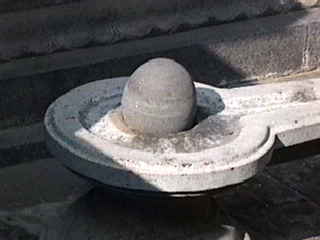The non antrhropomorphic Lingam form
of Shiva is what is held in reverence in temples all over the sub continent. The
Lingam is a symbol. It is a symbol of that which is invisible yet
omnipresent. It is hence a a visible symbol of the Ultimate Reality which is present in us
(and in all objects of creation ).
The Shivalingam denotes the primeval
energy of the Creator.It is believed that at the end of all creation, during the great
deluge, all of the different aspects of God find a resting place in the Lingam; Bhrama is
absorbed into the right, Vishnu to the left and Gayatri into the heart. The Shivalingam is
also a representation of the infinite Cosmic Column of fire, whose origins, Vishnu and
Bhrama were unable to trace. (see Lingodbhavar).

Legend has it that Parvati fashioned a Shivalingam
with a fistful of sand at Kanchipuram and worshipped Shiva; this lingam is known as the Prithvilingam,
denoting the primordial element earth. Shivalingams in several temples are swayambus, or
that which appeared on their own, or that which is untouched by a chisel. On the other
hand, there are temples where the Shivalingam is carved out of stone and installed. The
highly polished Shivalingams of the Pallava period bear several stripes, as in the
Kailasanatha temple at Kanchipuram.
The Shivalingam is generally mounted on a circular or
quadrangular receptacle called the Avudaiyar. This pedestal is designed
so as to drain off the water offered during ablution ceremonies. In temples such as
Kanchipuram, abhishekam is offered only to the pedestal and not to the Shivalingam made of
sand. The bottom of the pedestal represents Bhrama, the octogonal middle represents Vishnu
and the upper circular portion represents Shiva. The upper portion of the Shivalingam may
be of various shapes, cylindrical, elliptical, umbrella shaped. Images may also be
(rarely) carved on a Shivalingam.
Nandi, the bull is depicted facing
the sanctum in all Saivite temples, symbolizing the human soul Jeevatma
yearning for realizing its oneness with Paramatma, the ultimate reality.
Typically, the processional bronze images of Shiva are
those of Somaskanda, Chandrasekhara, Bhikshatana
and Nataraja. Although in most Shiva temples, the central shrine
enshrining the Shivalingam is of the greatest importance, the Nataraja shrine is of
greater importance at Chidambaram, the Somaskandar -
Tyagarajar shrine is of greater significance at Tiruvarur.
